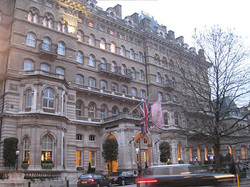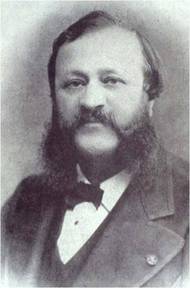Nitrous oxide
Nitrous oxide (or laughing gas) was popular at parties and fairgrounds in the early nineteenth century. Horace Wells suggested its use as an anaesthetic in the 1840s and conducted a sadly unsuccessful public demonstration in 1845.(1) When ether anaesthesia was demonstrated the following year, nitrous oxide was largely forgotten as an anaesthetic.
It was revived by an American dentist, Gardner Quincy Colton in 1862(2) and demonstrated by him in Paris in 1867. Dr Thomas Evans, an American resident of Paris and a fashionable dentist, asked to be taught the technique and was soon using it successfully in his practice. Nitrous oxide is far more pleasant to inhale than ether and has quite significant analgesic properties, making it more acceptable to his affluent dental patients.
It was revived by an American dentist, Gardner Quincy Colton in 1862(2) and demonstrated by him in Paris in 1867. Dr Thomas Evans, an American resident of Paris and a fashionable dentist, asked to be taught the technique and was soon using it successfully in his practice. Nitrous oxide is far more pleasant to inhale than ether and has quite significant analgesic properties, making it more acceptable to his affluent dental patients.
 Langham Hotel, London
|
Evans travelled to London the following year and, taking a room at the Langham Hotel, set up a Sprague nitrous oxide generator to fill india rubber bags for demonstrations around the city. Clover quickly realised that his chloroform apparatus could easily be adapted for nitrous oxide. Immediately after Evan's visit, the Odontological Society resolved that a committee should be formed to investigate nitrous oxide "...consisting of gentlemen practising as Dentists and Surgeons, and of the chloroformists Mr. Potter and Mr. Clover, who has specially given their attention to anaesthesia."(3) Nitrous oxide was vigorously debated at all the meetings of the Odontological Society of that year but, by November, it was becoming very popular with the dentists. Some, such as Clover, were also beginning to use it for minor surgical procedures. Later Joseph Clover developed the technique of using nitrous oxide as a carrier gas for ether with his combined ether/nitrous oxide equipment. This complicated piece of equipment was popular with Clover but many others preferred simpler ether inhalers. 1. I Awaken To Glory. Wolfe RJ, Menczer LF, editors. Massachusetts: Boston Medical Library; 1994. 2. Duncum BM. The Development of Inhalation Anaesthesia. Second ed. London: Oxford University Press; 1947 1994. 3.British Journal of Dental Science. 1868;2:213-485. |
< Back to Anaesthetist Next >
